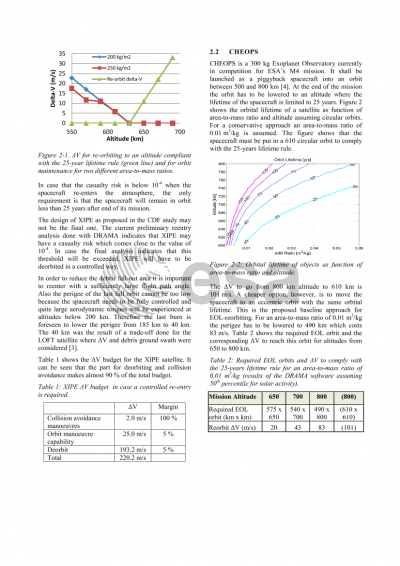Document details

Abstract
In March 2007 ESA released its Requirements on Space Debris Mitigation for ESA Projects to contribute to the efforts to limit the continuous growth of debris in orbit. Since then the requirements are applied during the mission design process of every new satellite. The Mission Analysis Section at ESOC is responsible for the trajectory design, the delta-V budget and the End-of-Life scenario definition for all ESA science missions as well as for most Earth observation and application satellites. Especially in CDF sessions, the mission analyst is responsible for the delta-V budget.
Two of the debris mitigation requirements have a significant influence on the delta-V budget of a mission: First the “25-year lifetime rule” and then the controlled de-orbit requirement, if the casualty risk during re-entry has a probability of more than 10-4. In this paper the implications of these two rules are described for a number of missions.
1) XIPE is a 1.2-ton X-ray Observatory in LEO. A re-entry analysis based on a preliminary design gave an on-ground casualty risk of about 10-4.. If it will turn out that a controlled re-entry is required 88% of the 220 m/s delta-V budget are allocated for the re-entry manoeuvres.
2) CHEOPS is a 300 kg Exoplanet Observatory currently in competition for ESA’s M4 mission. It shall be launched as a piggyback spacecraft into an orbit between 500 and 800 km. To cover for the highest orbit option, 83 m/s out of 105 m/s are allocated for re-orbiting at end-of-life to comply with the “25-year lifetime rule”.
3) Athena is a 5-ton X-ray Observatory to be launched in 2028 to a Sun-Earth libration point. 10 m/s are currently allocated for end-of-life disposal to reduce the risk that it will re-enter into the Earth atmosphere within 100 years. Also disposal manoeuvers for the mirror cover that shall be ejected a few days after launch are intensively studied.
4) Lisa Pathfinder currently in orbit about the Sun-Earth Libration Point 1 had no Delta-V allocation for the end-of-life scenario due to the status of the project when the space debris mitigation requirements came into place. However, a disposal will be performed on a best effort basis using the remaining propellant after end of the scientific phase. The probability of re-entry was studied over a period of up to 500 years to understand the long-term orbital behaviour.
5) BepiColombo, a 4-ton composite of two spacecraft bound to Mercury, shall be launched in 2018 on an Ariane.5 rocket. Mission analysis is tasked to find the best disposal manoeuvre for the upper stage that will minimise the re-entry risk during a launch window of 30 days.
The past ten years have shown that the space debris guidelines or requirements, respectively, are taken very serious at ESA. For missions in low-earth orbit their impact on the fuel budget is dominant. For libration point and interplanetary missions the fuel requirements are very modest, but the required analysis to prove that the long-term probability to interfere with the protected regions in GEO and LEO is very demanding in terms of CPU time. A special tool called SNAPPshot was developed for this purpose. SNAPPshot, which runs typically 50000 Monte Carlo simulations, provides the epoch, longitude, latitude, velocity and flight path angle for each simulated impact which can be used by the Space Debris Office to derive the casualty area.
Experience has shown that all ESA projects are meanwhile willing to pay the extra cost for the compliance with the space debris guidelines in order to avoid the further growth of debris and to keep the risk on ground below the required threshold.
Preview






